Items filtered by date: July 2022
An Infected Blister
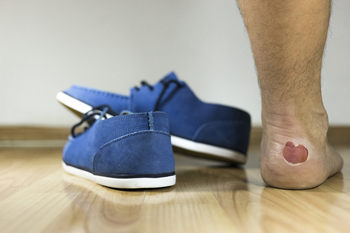
Blisters form when the skin is injured and are the body’s way of protecting itself from further damage. A blister is a bubble of fluid that collects to cushion the injury so the underlying skin can heal. Blisters show up on the feet when there is friction from shoes. If a blister breaks, bacteria can enter the wound and an infection can develop. This can be painful and dangerous if left untreated. Sepsis, or an infection can enter the bloodstream and be life-threatening. Most blisters are tender or painful when they occur but when one is infected, it is more apt to be warm, have oozing pus, have a foul smell, and be swollen. If you have a blister that appears to be infected, bleeds when you touch it, or does not seem to be healing, it is suggested you contact a podiatrist for an examination and proper treatment.
Blisters are prone to making everyday activities extremely uncomfortable. If your feet are hurting, contact one of our podiatrists of Total Podiatry. Our doctors can provide the care you need to keep you pain-free and on your feet.
Foot Blisters
Foot blisters develop as a result of constantly wearing tight or ill-fitting footwear. This happens due to the constant rubbing from the shoe, which can often lead to pain.
What Are Foot Blisters?
A foot blister is a small fluid-filled pocket that forms on the upper-most layer of the skin. Blisters are filled with clear fluid and can lead to blood drainage or pus if the area becomes infected.
How Do Blisters Form?
Blisters on the feet are often the result of constant friction of skin and material, usually by shoe rubbing. Walking in sandals, boots, or shoes that don’t fit properly for long periods of time can result in a blister. Having consistent foot moisture and humidity can easily lead to blister formation.
Prevention & Treatment
It is important to properly care for the affected area in order to prevent infection and ease the pain. Do not lance the blister and use a Band-Aid to provide pain relief. Also, be sure to keep your feet dry and wear proper fitting shoes. If you see blood or pus in a blister, seek assistance from a podiatrist.
If you have any questions, please feel free to contact our offices located in San Antonio, and Uvalde, TX . We offer the newest diagnostic and treatment technologies for all your foot care needs.
The Danger of Ignoring Toenail Fungus
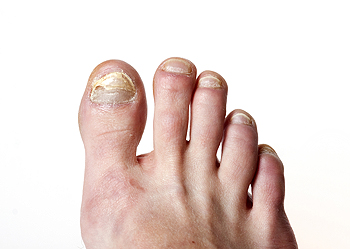
Toenail fungus, or onychomycosis, can be an unsightly condition to have. It usually appears as a white or yellow spot under the tip of the toenail. This infection often comes from walking barefoot in a public bathroom, locker room, or swimming pool area. It is important to treat this condition immediately to prevent it from worsening, spreading, or causing more serious complications. The fungi that cause this infection are contagious and can spread to other parts of the body, even the blood. Most often, they spread to other nails on the feet or hands. Antifungal medicine is usually used to combat the problem. Ways to prevent toenail fungus include using antifungal powder on the feet each day, not sharing shoes or socks, washing and drying feet regularly, wearing breathable shoes, and not walking barefoot. If you suspect you have toenail fungus, contact a podiatrist as soon as possible for proper diagnosis and treatment.
For more information about treatment, contact Neeta Hasmukh, DPM of Total Podiatry. Our doctor can provide the care you need to keep you pain-free and on your feet.
Toenail Fungus Treatment
Toenail fungus is a condition that affects many people and can be especially hard to get rid of. Fortunately, there are several methods to go about treating and avoiding it.
Antifungals & Deterrence
Oral antifungal medicine has been shown to be effective in many cases. It is important to consult with a podiatrist to determine the proper regiment for you, or potentially explore other options.
Applying foot powder on the feet and shoes helps keep the feet free of moisture and sweat.
Sandals or open toed shoes – Wearing these will allow air movement and help keep feet dry. They also expose your feet to light, which fungus cannot tolerate. Socks with moisture wicking material also help as well.
If you have any questions please feel free to contact our offices located in San Antonio, Uvalde, and Jourdanton, TX . We offer the newest diagnostic tools and technology to treat your foot and ankle needs.
The Danger of Ignoring Toenail Fungus

Toenail fungus, or onychomycosis, can be an unsightly condition to have. It usually appears as a white or yellow spot under the tip of the toenail. This infection often comes from walking barefoot in a public bathroom, locker room, or swimming pool area. It is important to treat this condition immediately to prevent it from worsening, spreading, or causing more serious complications. The fungi that cause this infection are contagious and can spread to other parts of the body, even the blood. Most often, they spread to other nails on the feet or hands. Antifungal medicine is usually used to combat the problem. Ways to prevent toenail fungus include using antifungal powder on the feet each day, not sharing shoes or socks, washing and drying feet regularly, wearing breathable shoes, and not walking barefoot. If you suspect you have toenail fungus, contact a podiatrist as soon as possible for proper diagnosis and treatment.
For more information about treatment, contact one of our podiatrists of Total Podiatry. Our doctors can provide the care you need to keep you pain-free and on your feet.
Toenail Fungus Treatment
Toenail fungus is a condition that affects many people and can be especially hard to get rid of. Fortunately, there are several methods to go about treating and avoiding it.
Antifungals & Deterrence
Oral antifungal medicine has been shown to be effective in many cases. It is important to consult with a podiatrist to determine the proper regiment for you, or potentially explore other options.
Applying foot powder on the feet and shoes helps keep the feet free of moisture and sweat.
Sandals or open toed shoes – Wearing these will allow air movement and help keep feet dry. They also expose your feet to light, which fungus cannot tolerate. Socks with moisture wicking material also help as well.
If you have any questions please feel free to contact our offices located in San Antonio, and Uvalde, TX . We offer the newest diagnostic tools and technology to treat your foot and ankle needs.
Wearing Running Shoes for Fitness Walking
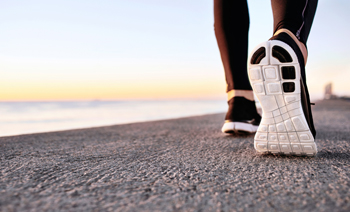 The age-old question of what type of shoes to wear for walking, especially fitness walking, continues. While runners have different needs compared to fitness walkers, and some running shoes would not be appropriate for walking, some of the shoes designed for walking can be even worse. Some walking shoes are made more for comfort and work purposes than walking for fitness. These types of shoes are highly cushioned to relieve stress from standing and may be heavy and not as flexible as needed. Running shoes tend to have more of the latest developments in technology with respect to cushioning for fitness walking, as well as motion control, and support. When choosing a running shoe for fitness walking, running stores can help you determine if you need motion control shoes, stability shoes, or neutral, lightweight trainers. The shoe you get should bend some and be able to be flexed at the forefoot. Look for shoes of 10 mm or less of a heel-to-toe drop. Make sure the heel of the shoe is undercut and angles in from the heel to the ground rather than being flared. Most importantly, make sure they feel comfortable. For additional help picking the right shoe for your particular foot and the needs of fitness walking or any other exercise you plan to embark upon, visit a podiatrist, who can examine your feet and gait and make specialized recommendations.
The age-old question of what type of shoes to wear for walking, especially fitness walking, continues. While runners have different needs compared to fitness walkers, and some running shoes would not be appropriate for walking, some of the shoes designed for walking can be even worse. Some walking shoes are made more for comfort and work purposes than walking for fitness. These types of shoes are highly cushioned to relieve stress from standing and may be heavy and not as flexible as needed. Running shoes tend to have more of the latest developments in technology with respect to cushioning for fitness walking, as well as motion control, and support. When choosing a running shoe for fitness walking, running stores can help you determine if you need motion control shoes, stability shoes, or neutral, lightweight trainers. The shoe you get should bend some and be able to be flexed at the forefoot. Look for shoes of 10 mm or less of a heel-to-toe drop. Make sure the heel of the shoe is undercut and angles in from the heel to the ground rather than being flared. Most importantly, make sure they feel comfortable. For additional help picking the right shoe for your particular foot and the needs of fitness walking or any other exercise you plan to embark upon, visit a podiatrist, who can examine your feet and gait and make specialized recommendations.
For more information about walking shoes versus running shoes, consult with Neeta Hasmukh, DPM from Total Podiatry. Our doctor can measure your feet to determine what your needs are and help you find an appropriate pair of footwear.
Foot Health: The Differences between Walking & Running Shoes
There are great ways to stay in shape: running and walking are two great exercises to a healthy lifestyle. It is important to know that running shoes and walking shoes are not interchangeable. There is a key difference on how the feet hit the ground when someone is running or walking. This is why one should be aware that a shoe is designed differently for each activity.
You may be asking yourself what the real differences are between walking and running shoes and the answers may shock you.
Differences
Walking doesn’t involve as much stress or impact on the feet as running does. However, this doesn’t mean that you should be any less prepared. When you’re walking, you land on your heels and have your foot roll forward. This rolling motion requires additional support to the feet.
Flexibility – Walking shoes are designed to have soft, flexible soles. This allows the walker to push off easily with each step.
If you have any questions, please feel free to contact our offices located in San Antonio, Uvalde, and Jourdanton, TX . We offer the newest diagnostic and treatment technologies for all your foot care needs.
Wearing Running Shoes for Fitness Walking
 The age-old question of what type of shoes to wear for walking, especially fitness walking, continues. While runners have different needs compared to fitness walkers, and some running shoes would not be appropriate for walking, some of the shoes designed for walking can be even worse. Some walking shoes are made more for comfort and work purposes than walking for fitness. These types of shoes are highly cushioned to relieve stress from standing and may be heavy and not as flexible as needed. Running shoes tend to have more of the latest developments in technology with respect to cushioning for fitness walking, as well as motion control, and support. When choosing a running shoe for fitness walking, running stores can help you determine if you need motion control shoes, stability shoes, or neutral, lightweight trainers. The shoe you get should bend some and be able to be flexed at the forefoot. Look for shoes of 10 mm or less of a heel-to-toe drop. Make sure the heel of the shoe is undercut and angles in from the heel to the ground rather than being flared. Most importantly, make sure they feel comfortable. For additional help picking the right shoe for your particular foot and the needs of fitness walking or any other exercise you plan to embark upon, visit a podiatrist, who can examine your feet and gait and make specialized recommendations.
The age-old question of what type of shoes to wear for walking, especially fitness walking, continues. While runners have different needs compared to fitness walkers, and some running shoes would not be appropriate for walking, some of the shoes designed for walking can be even worse. Some walking shoes are made more for comfort and work purposes than walking for fitness. These types of shoes are highly cushioned to relieve stress from standing and may be heavy and not as flexible as needed. Running shoes tend to have more of the latest developments in technology with respect to cushioning for fitness walking, as well as motion control, and support. When choosing a running shoe for fitness walking, running stores can help you determine if you need motion control shoes, stability shoes, or neutral, lightweight trainers. The shoe you get should bend some and be able to be flexed at the forefoot. Look for shoes of 10 mm or less of a heel-to-toe drop. Make sure the heel of the shoe is undercut and angles in from the heel to the ground rather than being flared. Most importantly, make sure they feel comfortable. For additional help picking the right shoe for your particular foot and the needs of fitness walking or any other exercise you plan to embark upon, visit a podiatrist, who can examine your feet and gait and make specialized recommendations.
For more information about walking shoes versus running shoes, consult with one of our podiatrists from Total Podiatry. Our doctors can measure your feet to determine what your needs are and help you find an appropriate pair of footwear.
Foot Health: The Differences between Walking & Running Shoes
There are great ways to stay in shape: running and walking are two great exercises to a healthy lifestyle. It is important to know that running shoes and walking shoes are not interchangeable. There is a key difference on how the feet hit the ground when someone is running or walking. This is why one should be aware that a shoe is designed differently for each activity.
You may be asking yourself what the real differences are between walking and running shoes and the answers may shock you.
Differences
Walking doesn’t involve as much stress or impact on the feet as running does. However, this doesn’t mean that you should be any less prepared. When you’re walking, you land on your heels and have your foot roll forward. This rolling motion requires additional support to the feet.
Flexibility – Walking shoes are designed to have soft, flexible soles. This allows the walker to push off easily with each step.
If you have any questions, please feel free to contact our offices located in San Antonio, and Uvalde, TX . We offer the newest diagnostic and treatment technologies for all your foot care needs.
Common Foot Problems as You Age
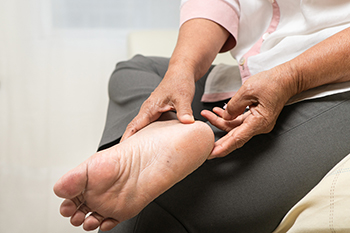
By the time you reach the age of 50, experts say, you may have put some 75,000 miles on your feet. Like a car with the same mileage, parts may start to break down and need repair. Your feet are no exception. The fatty padding starts to diminish in the heel and ball of the foot. Without an increase of cushioning in the shoes, this can become increasingly painful. A lifetime of wearing high heels, flip flops or other ill-fitting footwear starts to take a toll as you age. The chances of forming calluses, corns, hammertoes, or bunions increase. Ailments, such as gout, plantar fasciitis, and Achilles tendonitis are more likely. The onset of diabetes or blood circulation issues are common, causing sores and blisters on the feet to take longer to heal. Foot ulcers can develop, which may lead to further and more serious problems. Your tendons may tighten, causing a decrease in flexibility. At the same time, the ligaments begin to stretch, which can lead to flat feet and an increased risk of ankle sprains. After 50, taking your feet for granted is no longer an option. It is a good idea to make regular appointments with a podiatrist to monitor your feet as you move into your senior years.
Proper foot care is something many older adults forget to consider. If you have any concerns about your feet and ankles, contact Neeta Hasmukh, DPM from Total Podiatry. Our doctor can provide the care you need to keep you pain-free and on your feet.
The Elderly and Their Feet
As we age we start to notice many changes in our body, but the elder population may not notice them right away. Medical conditions may prevent the elderly to take notice of their foot health right away. Poor vision is a lead contributor to not taking action for the elderly.
Common Conditions
- Neuropathy – can reduce feeling in the feet and can hide many life-threatening medical conditions.
- Reduced flexibility – prevents the ability of proper toenail trimming, and foot cleaning. If left untreated, it may lead to further medical issues.
- Foot sores – amongst the older population can be serious before they are discovered. Some of the problematic conditions they may face are:
- Gouging toenails affecting nearby toe
- Shoes that don’t fit properly
- Pressure sores
- Loss of circulation in legs & feet
- Edema & swelling of feet and ankles
Susceptible Infections
Diabetes and poor circulation can cause general loss of sensitivity over the years, turning a simple cut into a serious issue.
If you have any questions please feel free to contact our offices located in San Antonio, Uvalde, and Jourdanton, TX . We offer the newest diagnostic and treatment technologies for all your foot and ankle needs.
Common Foot Problems as You Age

By the time you reach the age of 50, experts say, you may have put some 75,000 miles on your feet. Like a car with the same mileage, parts may start to break down and need repair. Your feet are no exception. The fatty padding starts to diminish in the heel and ball of the foot. Without an increase of cushioning in the shoes, this can become increasingly painful. A lifetime of wearing high heels, flip flops or other ill-fitting footwear starts to take a toll as you age. The chances of forming calluses, corns, hammertoes, or bunions increase. Ailments, such as gout, plantar fasciitis, and Achilles tendonitis are more likely. The onset of diabetes or blood circulation issues are common, causing sores and blisters on the feet to take longer to heal. Foot ulcers can develop, which may lead to further and more serious problems. Your tendons may tighten, causing a decrease in flexibility. At the same time, the ligaments begin to stretch, which can lead to flat feet and an increased risk of ankle sprains. After 50, taking your feet for granted is no longer an option. It is a good idea to make regular appointments with a podiatrist to monitor your feet as you move into your senior years.
Proper foot care is something many older adults forget to consider. If you have any concerns about your feet and ankles, contact one of our podiatrists from Total Podiatry. Our doctors can provide the care you need to keep you pain-free and on your feet.
The Elderly and Their Feet
As we age we start to notice many changes in our body, but the elder population may not notice them right away. Medical conditions may prevent the elderly to take notice of their foot health right away. Poor vision is a lead contributor to not taking action for the elderly.
Common Conditions
- Neuropathy – can reduce feeling in the feet and can hide many life-threatening medical conditions.
- Reduced flexibility – prevents the ability of proper toenail trimming, and foot cleaning. If left untreated, it may lead to further medical issues.
- Foot sores – amongst the older population can be serious before they are discovered. Some of the problematic conditions they may face are:
- Gouging toenails affecting nearby toe
- Shoes that don’t fit properly
- Pressure sores
- Loss of circulation in legs & feet
- Edema & swelling of feet and ankles
Susceptible Infections
Diabetes and poor circulation can cause general loss of sensitivity over the years, turning a simple cut into a serious issue.
If you have any questions please feel free to contact our offices located in San Antonio, and Uvalde, TX . We offer the newest diagnostic and treatment technologies for all your foot and ankle needs.
Get Professional Care for a Broken Foot or Ankle
Get Professional Care for a Broken Foot or Ankle
Benefits of Custom Orthotics
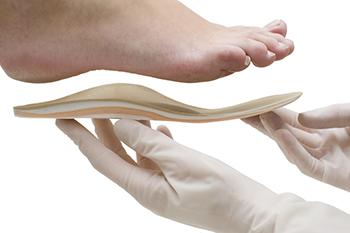
Scores of factory shoe inserts are readily available, but sometimes it becomes necessary to have insoles made specific to your feet. A podiatrist can make a mold for an insole that mirrors the exact contours of your foot. Slipping this into your shoe can increase your stability and balance while also reducing the pressure on the bottom of the foot when you take a step. These pressure points can have a negative effect on plantar fasciitis, poor circulation, and other causes of foot pain. Your podiatrist can also examine your gait–how your foot reacts when you stand or walk–to determine what additional adjustments may be needed to correct things like overpronation, flat feet, high arches, bunions, or metatarsal pressure. Custom orthotics may improve your foot health and keep you on your feet with minimal pain. If you frequently experience foot pain or have ongoing foot problems, it is a good idea to make an appointment with a podiatrist for more information.
If you are having discomfort in your feet and would like to try orthotics, contact Neeta Hasmukh, DPM from Total Podiatry. Our doctor can provide the care you need to keep you pain-free and on your feet.
What Are Orthotics?
Orthotics are inserts you can place into your shoes to help with a variety of foot problems such as flat feet or foot pain. Orthotics provide relief and comfort for minor foot and heel pain but can’t correct serious biomechanical problems in your feet.
Over-the-Counter Inserts
Orthotics come in a wide variety of over-the-counter inserts that are used to treat foot pain, heel pain, and minor problems. For example, arch supports can be inserted into your shoes to help correct overarched or flat feet, while gel insoles are often used because they provide comfort and relief from foot and heel pain by alleviating pressure.
Prescription Orthotics
If over-the-counter inserts don’t work for you or if you have a more severe foot concern, it is possible to have your podiatrist prescribe custom orthotics. These high-quality inserts are designed to treat problems such as abnormal motion, plantar fasciitis, and severe forms of heel pain. They can even be used to help patients suffering from diabetes by treating foot ulcers and painful calluses and are usually molded to your feet individually, which allows them to provide full support and comfort.
If you are experiencing minor to severe foot or heel pain, it’s recommended to speak with your podiatrist about the possibilities of using orthotics. A podiatrist can determine which type of orthotic is right for you and allow you to take the first steps towards being pain-free.
If you have any questions please contact our offices located in San Antonio, Uvalde, and Jourdanton, TX . We offer the newest diagnostic and treatment technologies for all your foot and ankle needs.

